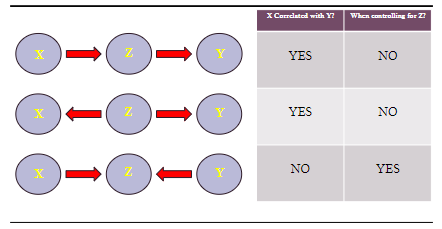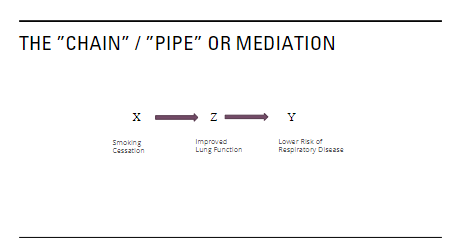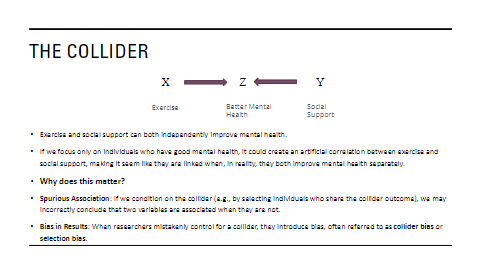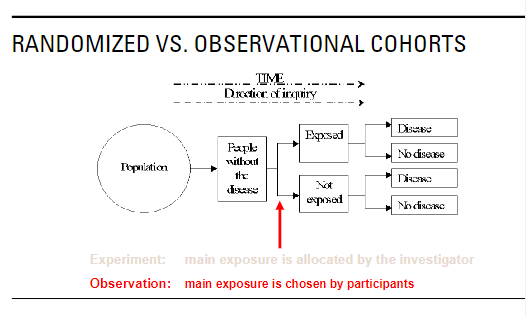Module 4: Significance of Research Designs + (Causality & AGS Review)
1/45
There's no tags or description
Looks like no tags are added yet.
Name | Mastery | Learn | Test | Matching | Spaced |
|---|
No study sessions yet.
46 Terms
DAGS (Directed Acyclic Graphs)
Usage:
Visually represent and clarify relationships between variables
Helps researcher visualize:
How different variables may be related
Which variables may be confounding the association of interest
Based on theoretical and substantive knowledge about the subject matter
Why Would Researcher use a DAG?
Can help one design a study
Identify variables in analyses that one needs to control in order to a exclude alternative explanation for the pattern one finds
Brief Overview of Causal Modeling
Relationships between variables X, Y and Z can take different forms
Three common structures:
(1) Mediation Structure (X → Z → Y)
X is the independent variable, Z is the mediator, Y is the dependent variable
X influences Y through Z where Z transmits some or all of the effect of X on Y
(2) Fork Structure (X ← Z → Y)
Z is the common cause of both X and Y (Z is a confounder)
X and Y are not directly connected (don’t directly influence each other), but share a common ancestor in Z
(3) Collider Structure (X → Z ← Y)
X and Y both (are not correlated) influence Z, but Z does not mediate between them

Why Does a Mediation Structure Matter?
Not accounting for the mediator can:
Result in falsely attributing the entire effect of the cause directly to the outcome
Lead to an overestimation of the direct effect of the independent variable on the dependent variable
We may miss important intervention points that could be targeted for improving outcomes

Why Does a Fork Structure Matter?
Spurious correlation: Without account for the common cause, two variables (X & Y) might appear related when, in related, their association to due to the confounder (Z)
Overestimating Direct Effects: Forks can make us overestimate the direct effect between two variables by not recognizing the role of a 3rd factor (the common cause)

Why Does A Collider Structure Matter?
Spurious Association: If we condition on the collider (eg. by selecting individuals who share the collider outcome)m we may incorrectly conclude that two variables are associated when they are not
X and Y can both independently affect Z
X and Y are not linked, just that that they affect separately!
Bias in Results: When researcher mistakenly control for a collider, they introduce boas often referred as collider bias/selection bias

Research Design
Structured framework that outline how a research study will be conducted to answer a specific set of questions or hypotheses
Provides a detailed plan specifying methods and procedures for collecting and analyzing required information
RD because it affects:
(1) Reliability, (2) Validity, (3) Generalizability of study findings
How Does Research Design Help the Researcher?
Address Research Questions
Clear path to answer research questions
Test hypotheses set out at the beginning of studies
Validity
Study measures what it intends to measure
Minimizes biases and other errors that can invalidate the study
Reliability
Study has consistent and repeatable results
Copyable where other researchers will yield the similar results if conducted
Generalizability
Results are generalizable to broader population and different contexts
Types of Validity
Construct Validity
Content Validity
Internal Validity
External Validity
Construct Validity
Actually reflects the true theoretical meaning of concept
eg. self-esteem, not another related construct such as confidence
Content Validity
Assures that a measure covers all aspect of a given construct
eg. depression scale measuring all facets of depression, not just sadness
Internal & External Validity
Internal Validity
Concerned with the results of a study and their attribution to the independent variable, and not some other factor
External Validity
Generatability of research results
Descriptive Research Designs
(1) Case Reports
(2) Case Series
Do a great job at answering all the Ws except the why
Case Reports (Descriptive) → Interchangeable with Case Studies
Article that describes and interprets an individual case that is written like a detailed story
First line of evidence, but also lowest level
New issues and idea come out of here (low on hierarchy pyramid)
Good case report will always be clear about the importance of the observation being reported
Case Studies Advantages
Assist in:
Identification of new trends and diseases
Detect new drug side effect and potential uses (Adverse or beneficial)
Educational
Identify rare manifestation in disease
Case Study Disadvantages
Cases may not be generalizable
Causes/associations may have other explanations
Potentially viewed as
Emphasizing the bizarre
Focusing on misleading elements
Case Series (Descriptive)
Track cases/patients who possess a specific disease or disease-related outcome OR examines patients medical records for exposure and outcome (H. Lacks doctor did not do this shi btw 😭)
“Series” = likely to be small sample
Case Series Advantages
Simple + inexpensive
Useful for rare conditions
Generates hypotheses
Real-world observations
Quick publication
Case Series Disadvantages
No control group
Lower level of evidence
Potential for bias
Does not establish causation
Susceptible to findings by plain chance
Lack of statistical rigor
Commitment to best practices in research
Observational Research Designs
(1) Cross-sectional
(2) Case-control
(3) Cohort
Observe naturally what is going on in the world without interfering in-between
Cross Sectional Study Design (Observational)
A type of research (observational) that examine a group of individuals at one point in time to gather data on various variables
Provide a snapshot of the population at a single moment (Hook-up one and done ah)
In kinesiology, can be:
Assessing PA factors, biomechanical measures, or any other related factors in a given population
Cross Sectional Study Design Advantages
Efficient
Good for descriptive analysis
No dropouts
Establishing prevalence
Proportion of population who possess certain characteristic(s)
Cross Sectional Study Design Disadvantages
Does not determine causality
Temporal sequence unclear
Potential for bias
Snapshot has limitations
Cohort Study Design (Observational)
Any designation group of persons who are followed over a period of time (Not in a snapshot like Cross Sectional)
Exposure not randomized (participants are selected based on their exposure status and evaluated for occurence of the outcome of interest), but allows for sample to vary naturally as it not in the researchers control
In other words, observe how exposure to certain factors (this creates exposure status) affect the development of specific outcomes
Does exposure to this = often see this outcome???
eg. a cohort study examining how smoking (exposure) affects the incidence of lung cancer (outcome) by following a group of smokers and non-smokers over several years.
Traditional epidemiology:
Likes to compares occurrences of disease within one or more cohorts (eg. one exposed to some exposure/treatment vs. non-exposed → Jonkler ah study)
Difference Between Randomized vs. Observational Cohorts
*Refer to photo
Experiment = Randomized
Observation = Observation

Why an Observational Cohort and not a Randomized Cohort?
In place for exposure that can not randomized (ethically, or practically)
Cohort studies (Secondary analysis of existing data) provide good information to guide action
To reflect reality better
Experimental conditions limit this
Can be prospective (future) or retrospective (past)
Note: can argue randomized trial is a prospective observational cohort with additional conditions → randomized assignment of standardized (consistent) treatment
Fundamental study design
*Note Image to clarify prospective and retrospective cohort studies

Cohort Study Design Advantage
Causality
Rare exposures
Temporal sequences
Reduce recall bias
Direct measures
Cohort Study Design Disadvantages
Cost and time
Loss to follow-up
Changes over time
Rare outcomes
Confounding
Mixing of effects resulting in a distortion of the true relationship
Case Control Study Design (Observational)
Type of study (observational) which situates two existing groups differing in outcome and are compared on the basis of some supposed causal attribute
Participants here selected for outcome status
Often used to identify factors that may contribute to medical conditions
Compare subject:
(1) Who have the condition/diseases (“the “cases”)
(2) Those who do not, but are otherwise similar (the “controls”)
Idea Behind “Sampled Exposures”
A concept of case-control study that looks to increase efficiency of a study by sampling
Case-Control Study Design Advantages
Good use for:
Rare diseases
Diseases with a long latency period between exposure and ideas manifestation
Less costly and time consuming
Advantageous in terms of exposure data (becomes hard or expensive to obtain)
Case-Control Study Design Disadvantages
Selection bias may be present
Inefficient for rare exposures
Info on exposure subject to observation bias
Finding appropriate control group sometimes proves to be difficult
Experimental Research Design
(1) Lab Trials
(2) Field Trials
Always implies cause and effect link
Experimenter controls for everything but the variable of interest
First Controlled Experiment EVERRRR! (Brainrot)
Daniel BIBLICAL!
King wanted some people to serve in his court
As part of their education, they would receive royal meat and wine
Daniel (true sigma btw) refused sat nah vro, I love God and my religion, and asked that he and his friends be given a diet of vegetables instead
Assured this vegetarian diet will not diminish their capacities to serve the king
To prove this theory, Daniel proposed an experiment (wtf)
10 days, 4 of us only vegetable, another grup have only king’s meat and wine
After 10 days is up, compare the two groups, “And as thou seest, deal with thy servants”
Principles of Daniel’s Experiment
Groups are comparable and representative of some population → generalizability
This was a prospective type of study
Groups chosen in advance
Two things Daniel didn’t have in his study that is otherwise important today
Blinding
Selection bias
Randomized Trial
Group of individuals who are randomly assigned to 2 or more treatment groups and the followed up until outcome/end of study
Usually there is an active arm vs. a placebo arm
Drug Trials: Classic Example of Experimental Research
Medication we are prescribe conducted through drug trials
Groups being assigned randomly → technical name: Randomized control trials
In experimental research, experimenters are always manipulating the world to case a change, so in theory, everything but the effect of the drug has been controlled for
Types of Randomization
(1) Individual Randomization
(2) Blocked Randomization
(3) Cluster Randomization
Individual Randomization
Example: each person flips a coin
Blocked Randomization
Random order within a fixed block of a set size
Guarantees equal (or near-equal) numbers in each study arm
Advantageous in smaller studies where larger numbers may be less reliable
Cluster Randomization
Community or group or classroom get the intervention
eg. intervention is a radio campaign to encourage exercise
Blinding (Masking)
Some participants are unaware who is in which arm during the trial
eg. trial of an active drug vs. a placebo
Patients unaware if in active or placebo
Study staff do not also know (Wth)
Individuals and/or data do not know which arm of the trial is which (is active or placebo?)
Causality with Randomized Control Trials
Causal inference principles
Exchangeability
Positivity
Consistency
Temporality
How Are Such Principles Met?
Take placebo-controlled randomized trial
Everyone assigned either the treatment or placebo in the same way, therefore, having no variation the treatment assignment → CONSISTENCY
Everyone who enter the trial have a nonzero chance of being assigned to each of treatment & placebo (and getting it) → POSITIVITY
meaning, no participant is excluded from either possibility
Every for example 25 year old gooner named Jelqseph who is assigned, a 25 year old gooner named Jelqseph is assigned placebo → EXCHANGEABILITY
That is if trial has a large number of people
Randomized Study Design Advantages
Unambiguous temporal sequence - exposure precedes outcome
Ensures
Positivity, consistency by design
Exchangeability in expectation - including by known and unknown factors
Randomized Study Design Disadvantages
Expense and organization
Many pitfalls potentially in study implementation
Vulnerable to loss to follow-up & missing data
Lack of generalizability
Typically only assess outcomes in the short-term
Many determinants of health cannot be randomized